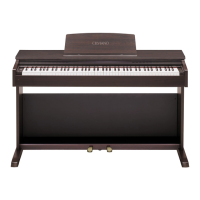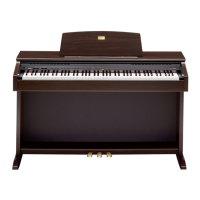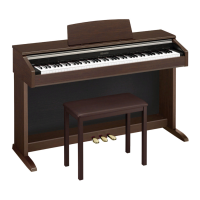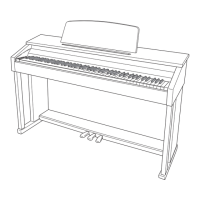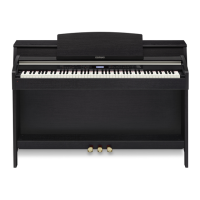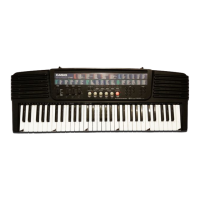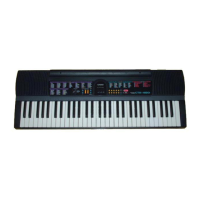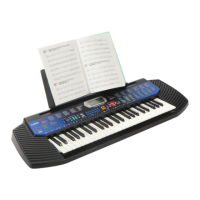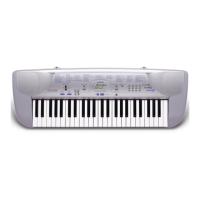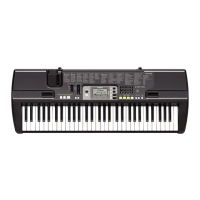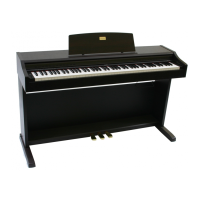
Do you have a question about the Casio CELVIANO AP-31V and is the answer not in the manual?
| Brand | Casio |
|---|---|
| Model | CELVIANO AP-31V |
| Category | Electronic Keyboard |
| Language | English |
Warnings about modifications affecting FCC compliance.
Explanations and examples of safety symbols used in the manual.
Recommended and prohibited locations for placing the piano.
Guidelines for cleaning and maintaining the piano.
Information about the internal lithium battery for memory backup.
Description of the eight built-in instrument tones.
Information about the metronome function for practice.
Details on the eight built-in demo tunes.
Information on storing and playing back performances.
Functions like Transpose, Tuning, and Touch Select.
Connecting to other MIDI devices.
Information on connecting and using headphones.
Description of the front panel controls and indicators.
Description of connections on the back panel.
Explanation of keyboard note naming and positioning.
How to select and use the instrument's tones.
How to apply and use digital effects like Reverb and Chorus.
Information about the number of notes that can be played simultaneously.
How keyboard touch affects volume and sound.
Explanation of how tones are produced using digital samples.
Explanation of the functions of the damper, soft, and sostenuto pedals.
How to adjust the volume of the metronome.
Details on memory capacity and recorded data.
Step-by-step guide to recording keyboard performances.
Procedure for deleting recorded memory data.
How to play all demo tunes sequentially.
How to select and play individual demo tunes.
How to stop the demo tune playback.
Adjusting keyboard touch sensitivity for playing style.
Changing the piano's pitch to suit other instruments or vocals.
Explanation of Musical Instrument Digital Interface.
Overview of MIDI functions, connections, channels, and multi-timbre.
Sending recorded memory data via MIDI.
Explanation of the General MIDI System standard.
Managing the connection between keyboard and sound source.
Steps to resolve issues with no sound output.
Causes and solutions for the keyboard being out of tune.
Troubleshooting pedal effect issues.
Solutions for no sound during demo tune playback.
Addressing issues with deleted memory contents.
Troubleshooting MIDI sound output issues.
Step-by-step instructions for assembling the piano stand.
How to attach the score stand.
Default settings of the piano when powered on.
Details on MIDI channel messages, including note and control changes.
Explanation of Note On/Off messages and velocity.
MIDI Control Change messages for various functions.
Formats for Modulation Wheel, Portamento Time, and Data Entry.
MIDI formats for Expression, Hold, Portamento, Sostenuto, Soft, Resonance.
MIDI formats for Release Time and Attack Time.
NRPN details for Vibrato Rate and Depth.
RPN parameters defined by the instrument.
MIDI messages for Program Change, Pitch Bend, Channel Mode, All Sound Off, and Reset Controller.
Universal System Exclusive messages, including GM System On.
Overview of MIDI channel data formats.
MIDI Note On/Off and velocity data formats.
MIDI Control Change data formats.
Formats for Bank Select, Modulation Wheel, Portamento Time, and Data Entry.
MIDI formats for Portamento, Sostenuto, Soft, Resonance, Release, and Attack Time.
NRPN details for Vibrato Rate and Depth.
RPN parameters defined by the instrument.
Formats for Program Change, Pitch Bend, Channel Mode, All Sound Off, and Reset Controller.
Universal System Exclusive messages, including GM System On.
Chart of basic MIDI functions, modes, and note messages.
Chart of MIDI Control Change and Program Change messages.
Chart of System Exclusive, Common, Real Time messages and remarks.
Support for NRPN, RPN, All Sound Off, Reset Controller, and General MIDI compatibility.
